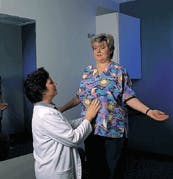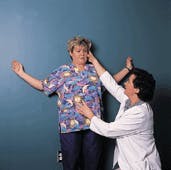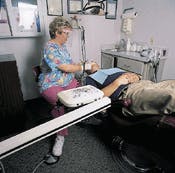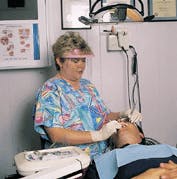Physical therapists analyze work-related distress, make recommendations for exercises
Mary Martha Stevens, RDH, PhD
The Lenexa Dental Group practices family and cosmetic dentistry in the heart of Lenexa, Kan., in a small, unpretentious office. Drs. Ayer, Kelly, and Pottinger look like college students; Dr. Chambless looks like one of their professors. At first glance, the Lenexa office appears to be just another home in a quiet, residential neighborhood. But in reality, the inhabitants of this group practice are committed to providing quality dentistry for generations to come, rather than assembly-line services for short-term financial gain.
How committed are these doctors? This small band of warriors supported Kansas dental hygienists in their recent battle with the Kansas Dental Associa-tion (KDA). The dentists wrote their state legislators opposing the proposed statutes that would allow dental assistants to scale and polish supragingivally.
It was this show of professionalism that convinced Susan Hendley, RDH, that she needed to quit several part-time positions to work full time for the Lenexa Group. As president of the Johnson County Dental Hygienists` Association and former president of the Kansas Dental Hygienists` Association, Hendley did not feel comfortable working with dentists who supported KDA`s efforts to reduce the standards of dental care in Kansas.
Working full-time at the Lenexa office meant that Hendley would have to change operatories to manage her new patient load. After several months in her new environment, Hendley began to experience excruciating pain in her shoulder. The pain became so intense that she couldn`t work. One of the Lenexa dentists suggested that she see one of their patients, who was a chiropractor. Since medication wasn`t alleviating the problem, Hendley gladly called for an appointment.
At the end of each chiropractic visit, Hendley felt significant relief. This would last for a few days and then the pain would return. When she continued to complain of her physical distress, another dentist in the practice commented that a certain amount of pain is common in dentistry, and this was something she would learn to live with. Hendley quickly responded that she had practiced for 21 years and had never experienced pain before. "I knew he was wrong," said Hendley. "I knew I wasn`t getting any long-term relief because only my symptoms were being treated."
Some of Hendley`s determination came from reading women`s magazines. Health authors often encourage readers to get a second opinion when physical problems continue to persist. Event-ually, a medical doctor recommended that Hendley see an orthopedic specialist. He verified that her neck was the source of the problem, not her shoulder. Physical therapy was prescribed.
"Kelly Ehrnman, my physical therapist, was the one who finally explained to me that I was tilting my head too far forward when I worked on patients, and this was placing too much stress on my shoulder muscles," Hendley commented. "Then, Kelly worked on my posture - not just my posture at work, but my sleeping and driving postures. Kelly even taught me how to adjust my car seat and rear-view mirror to alleviate neck strain," said Hendley.
Ehrnman told Hendley that her physical problems were associated with her transition to a new operatory. However, Ehrnman assured her that range-of-motion losses in her neck and shoulder had begun years before. The therapist then asked Hendley to look for ergonomic errors in the new operatory that might be causing her muscle imbalances to exhibit painful symptoms.
Unsure of her ability to hone in on the problem, Hendley asked a dental hygienist who routinely filled in at the office to help her identify what was ergonomically wrong. The dental hygienist found that Hendley was stretching to reach her instruments because the instrument- tray arm would not rotate to a comfortable working position. She also noticed that the cord on the rheostat was too short, forcing Hendley to extend her leg to reach the pedal. When the instrument-tray arm was repositioned on the operatory wall and the rheostat cord was lengthened, Hendley was able to work in a correct position.
Hendley`s recommendation to other dental hygienists who are experiencing pain: "Don`t give up on finding the solution to your particular problem. You don`t have to work and live in pain."
Mary Martha Stevens, RDH, PhD, is a RDH consulting editor. For many years, she was manager of health and wellness for Puritan-Bennett Corp. Currently, she is clinical associate professor, UMKC School of Dentistry. She can be contacted by e-mail at [email protected].
Factors that allowed Susan Hendley to practice dental hygiene pain-free
* Equipment adjustments in Hendley`s dental-hygiene operatory
* Six weeks of physical therapy
* Hendley`s commitment to practicing a variety of upper-body exercises on a daily basis
* Hendley`s commitment to maintaining a correct posture while working on patients
* Participating in yoga classes, which Ehrnman recommended, to increase and maintain flexibility and range of motion
Therapist develops exercise program for hygienist
"When Susan Hendley came to see me, she complained of some minor head and neck pain that was being referred to the lateral, upper arm region," recalls Kelly Ehrnman, RPT, registered physical therapist. Ehrnman is a member of the spine team at Shawnee Mission Medical Center, Shawnee Mission, Kan.
"Susan`s pain was worse after working a full day and less on the weekends, which is typical. When I evaluated Susan," Ehrnman continued, "I looked at her range-of-motion, posture, strength, and length of different muscles. Because Susan was sitting in a working position all day with her shoulders rounded, her chest muscles had shortened. We call this `adaptive shortening.` Over time, this becomes painful." Ehrnman also noted that the muscles on the back of Hendley`s shoulders had, in turn, become stretched and weak, which limited her ability to work without pain.
Ehrnman discovered that Hendley worked leaning forward, with her head tilted in a forward head posture, which caused connective tissues and muscles at the back of the skull to be shortened. "Even though the vertebrae in the upper spine are suppose to have a slight curve," Ehrnman said, "Susan`s curvature was greatly increased, causing spinal problems, too."
Ehrnman started Hendley`s treatments with massage to relax the tissues that were tight. Then, the physical therapist taught her exercises that would stretch and normalize her posture. The therapist clarified that Hendley`s move to a new operatory was not the cause of the muscle problems. "The imbalances had been coming on for years," said Ehrnman, "but the older-equipped operatory was `the straw that broke the camel`s back,` so to speak. One more stress was all it took."
"Pain should not be a part of dental-hygiene practice," Ehrnman emphasized. "It absolutely is abnormal. When a dental hygienist feels pain, then she needs to look for ways to change her working position."
Her "prescription" for Susan?
The upper-extremity stretch
The upper-extremity stretch is practiced sitting or standing, during or between patients, for 15-30 seconds, every 15 minutes throughout the work day. This exercise increases an ideal posture or neutral spine position. Ehrnman tilts Hendley`s chin down and positions her stomach muscles in. Arms are positioned close to the body. Elbows are bent 90 degrees. Palms are placed face up and fingers are pointed toward the floor. Shoulders then are rotated to allow the hands to be as far from the midline of the body as possible without squeezing the shoulder blades together.
Wall angels
Hendley performs this exercise between patients or during morning or afternoon breaks. Ehrnman coached Hendley to stand against a wall, chin tilted slightly down, stomach muscles in, arms close to the body, and elbows bent at a 90-degree angle. Feet are positioned a shoulder`s length apart and a foot from the wall, with knees slightly bent. With fingers pointed upward, Ehrnman guides Hendley`s arms slowly toward the ceiling and back down again.
Shoulder exercise
To increase the range of motion in Hendley`s shoulder, Ehrnman taught her an easy exercise that she could do in the evenings while watching television. Hendley lies on a firm surface with one elbow bent 90 degrees, fingers pointing toward the ceiling. A towel is placed under Hendley`s elbow. Ehrnman places a hand on Hendley`s shoulder to keep it from lifting up during the exercise. (At home, Hendley places her opposing hand on her shoulder to make sure it does not move.) Then, Ehrnman rotates Hendley`s hand toward the plinth (high-low table) and slowly back to the starting position. This is done 10 times with each arm, three times a day. In time, with full range of motion, Hendley`s hand was able to comfortably bend down two to three inches from the plinth.
Hendley`s working position before and after seeing a physical therapist
Before picture
Shoulders are rounded and head is tilted forward and slightly upward, forcing the spine into an unnatural position. The instrument tray and rheostat were difficult to reach.
After picture
Hendley works with shoulders and spine in a neutral position. Instrument tray arm has been repositioned on the operatory wall to allow the instruments to be within Hendley`s normal reach. Rheostat cord was lengthened for easy access.
Kelly Ehrnman, a physical therapist, guides Susan Hendley through the following exercises: (from left to right) the upper-extremity stretch, wall angels, and shoulder exercise.
Hendley`s operatory "before"
Hendley`s operatory "after"





